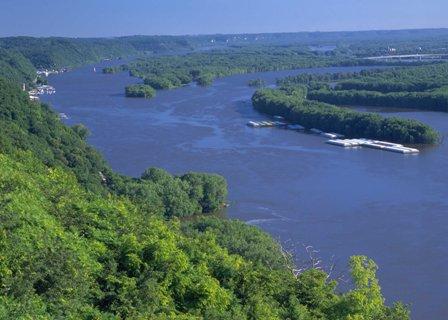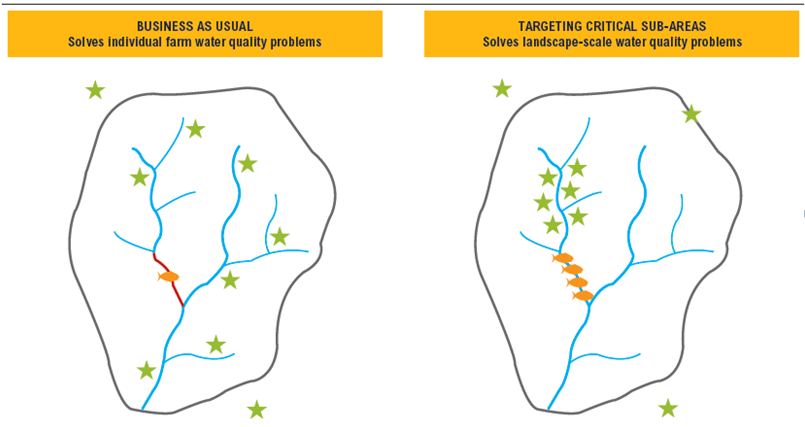
Water quality in the United States remains a major environmental and policy challenge. Water pollution is also a growing and serious problem across much of the world. Tackling water quality problems, particularly from diffuse sources such as agricultural farm fields, is a substantial challenge and much can be learned from the U.S. experience.
More than 15,000 streams, rivers, and lakes in the United States are too polluted with nutrient runoff to support wildlife, be enjoyed recreationally, or serve as a drinking water source. In the Mississippi River Basin (MRB), a region that encompasses about 41 percent of the continental United States, the majority of the local water quality pollution stems from farming activities involving fertilizer and livestock manure use. The MRB drains into the Gulf of Mexico, where the county’s largest “dead zone,” an oxygen-devoid region, forms every spring and wipes out aquatic life and fisheries.
Few programs have seen widespread success in tackling either local or the Gulf’s growing water quality problems, but an emerging initiative could present a way forward. The U.S. Department of Agriculture (USDA) launched the Mississippi River Basin Healthy Watersheds Initiative (MRBI) in 2009. New WRI research finds that with some specific improvements, the MRBI’s new approach could play a key role in improving the nation’s inland and coastal water quality.
A Growing Dead Zone Problem
When water bodies become over-enriched with nutrients like nitrogen and phosphorus they suffer from eutrophication, a condition in which harmful algae blooms rob the water of oxygen. Eutrophic waters can become “hypoxic,” or hold too little oxygen to support aquatic life, and large, persistent dead zones can occur. According to WRI’s interactive map of eutrophication and hypoxia, more than 500 coastal water bodies around the world currently suffer from dead zones. Most of the nutrient pollution comes from farm use of fertilizers and manure, while other sources include municipal sewage treatment plants and household septic tanks.
An Innovative Approach to Water Quality Management
The USDA has implemented conservation programs for decades in an effort to address on-farm environmental and natural resource problems like water pollution, habitat destruction, and degradation of wetlands. These programs focus on the farm scale, working one-on-one with farmers to solve problems on individual fields through the installation and maintenance of conservation practices like stream-side buffers, cover crops, and nutrient management plans. But while these programs have helped curb soil erosion, preserve wildlife habitat, and improve manure management on individual fields, they have failed to produce results at the scale necessary to cut back enough nutrient and sediment pollution to clean up nearby waterways.
So now the federal government is trying a new tack. The MRBI is one of handful of relatively new initiatives from the USDA’s Natural Resource Conservation Service (NRCS) that target conservation funding at the landscape scale rather than operating only at the individual farm-or-field scale.
MRBI is unique in that it uses a targeted watershed project and partnership approach to deliver the same financial and technical assistance NRCS has been providing for years. Rather than working with individual farmers dispersed across the rural landscape, NRCS now uses a portion of conservation program funds to work with many cooperating farmers located in selected, high-priority MRBI watersheds. Partners from state agricultural and water quality agencies, watershed groups, universities, and farm and environmental non-governmental organizations help in the implementation of these watershed projects. The idea is that by targeting multiple, strategically located farms in affected watersheds, MRBI will be able to improve the water quality of a stream or river in that watershed.
By taking this new approach, NRCS and its partners aim to implement the most cost-effective and appropriate conservation practices on a scale adequate enough to reduce the nutrient and sediment runoff impairing the project waterbody. The density and intensity of the conservation effort in an MRBI watershed means that MRBI projects are poised to generate both farm- and landscape-scale benefits. Over time, such projects will hopefully result in measurable improvements in local water quality and reduced dead zones.

Ensuring that the MRBI Leads to Success
The MRBI is still in its initial implementation phase, so it’s too early to assess exactly what impact it’s having on local water quality. We can, however, analyze how well the program is designed to achieve water quality outcomes. WRI’s new working paper, Improving Water Quality: A Review of the Mississippi River Basin Healthy Watersheds Initiative to Target U.S. Farm Conservation Funds, finds that the MRBI is off to a good start, but there is still room for improvement.
We found many strong programmatic and project design elements indicating that MRBI will help improve water quality. The vast majority of the initiative’s projects have partners with both water quality monitoring and conservation expertise. Two-thirds of the reviewed projects have ambitious, outcome-oriented goals that will allow the public to know what kinds of water quality improvements are being sought in the project waterbody. And NRCS, as well as the project leaders, reviewed appropriate scientific data and institutional capacity factors in selecting the MRBI watersheds and sub-watersheds in which to target conservation efforts.
Still, there are ways MRBI can be improved to ensure greater success. For one, monitoring efforts need to be strengthened. Though NRCS is providing oversight of the water quality monitoring stations placed on the fields of some volunteering farms, the agency has not yet taken a leadership role or designated another institution to oversee in-stream and watershed-outlet water quality monitoring. Achieving success requires a comprehensive review of monitoring results at all three scales—field, in-stream, and watershed outlet—which will allow NRCS and the project partners to make mid-course adjustments if needed.
In the medium- and long-term time horizons, we encourage NRCS to accelerate the roll-out of watershed-scale and farm-scale computer modeling tools. These tools will help project leaders conduct effective watershed-based project planning and evaluation. The tools will also enhance the ability of conservation planners to help farmers identify the most cost-effective practices — not only for their fields, but for the targeted watershed project, saving both farmers and taxpayers money. In other words, these tools can help NRCS get the most bang for the increasingly shrinking taxpayer buck.
With a few adjustments, the MRBI could demonstrate significant local water quality improvements over time. This success could not only begin the process of effectively chipping away at the Gulf of Mexico’s dead zone, it could help demonstrate that conservation-targeting partnerships are critical investments for our shared environmental future.
- CBCSD and Members Participated and Suggested on the Project for Technical Regulation on Low-carbon Pilot Community
- CBCSD and Members Participated in the APEC Cooperation Network Construction Forum of Green Supply Chain
- Calculation Method of CO2 Emissions in Petroleum and Natural Gas Exploitation Enterprises & Calculation Method of CO2 Emissions in Water Network of Chemical Enterprises
- CBCSD Attended the Workshop for Environmental Protection and Sustainable Development and Delivered Introductions
- WBCSD: Tackling the Challenge, How to Make Informed Choices on Forest Product?
- The National New-Type Urbanization Plan Released, Board Members of CBCSD Help the Sustainable Development of Cities
- Board members of CBCSD Actively Participated in the Carbon Trading and International Climate Change Process
- Two industrial Standards Compiled by CBCSD Passed Examination
- Widespread Use of the Achievements Businesses Energy Saving and Greenhouse Gas Management
- CBCSD held Chemical industry enterprise value chain (range 3) greenhouse gas emissions, accounting and reporting guidelines

